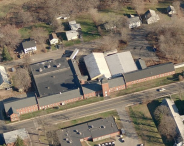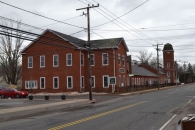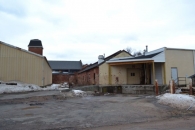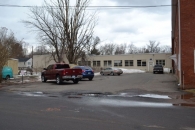Mill Record East Windsor
RETURN TO ‘FIND MILLS’Disclaimer: Content for these properties was compiled in 2014-2017 from a variety of sources and is subject to change. Updates are occasionally made under Property Information, however the Connecticut Trust for Historic Preservation (dba Preservation Connecticut) makes no representation or warranty that the information is complete or up-to-date.
- Complex Name (Common)
- Warehouse Point Silk Co.
- Complex Name (Historic)
-
- Warehouse Point Silk Co.
- Address or Location
- 132 Main Street, Warehouse Point, East Windsor
- County
- Hartford
- Historic Designation
- Associated Mill Community
- n/a

- Historic Information
Companies Associated w/Complex
- Leonard Silk Co. 1875-1893
- Warehouse Point Silk Co. 1893-1944
Use (Historic)
Largest Documented Workforce
160 (1918)
Historic Narrative
The location of the former Warehouse Point Silk Company mill began to be used for textile production as early as 1804, when Brazail Sexton established the East Windsor Woolen Company on the site. This failed shortly after the conclusion of the Civil War and then passed to the Stocker and Bently Company before it and 30 associated employee tenements were acquired by Jehiel Symonds in 1870. After purchasing the plant, Symonds partnered with J.N. Leonard to retrofit the mill for the production of silk thread, which was then conducted under the Leonard Silk Company. The four-story brick mill operated by the Leonard Silk Company was tragically destroyed by fire on December 16, 1874, however, the company quickly moved to rebuild and resume production. In less than one month the firm had erected a new dye house and powerplant and had installed enough machinery to begin work. The majority of the existing red brick mill was completed in short order and the Leonard Silk Company was soon up to full capacity. Demand for the company’s products continued through the early 1880s and the two-story red brick block at the northern end of the plant was added to house a new office and stock room ca. 1884. In March 1893 the stockholders of the Leonard Silk Company voted to change the name of the firm to the Warehouse Point Silk Company. This continued to be managed by Symonds until his death in 1909, whereupon his son, Robert H. Symonds took over as president and treasurer. Shortly thereafter, Symonds bought out Leonard’s share of the business and assumed full control of the business moving forward. Newspaper articles published in 1914 note that production at the Warehouse Point Silk Company were little effected by the outbreak of the First World War, however, the entire payroll of 160 employees was thrown out of work early in 1918 as a result of war-related coal rationing. The Warehouse Point Silk Company soon returned to full production and prospered through the 1920s, although technological developments during the late-1920s began to impact the profitability of many of Connecticut’s silk mills by the end of the decade. The most significant factor in this shift was the development of synthetic materials, such as rayon, which began to decrease the demand for silk sewing thread. Despite this fact, the Warehouse Point Silk Company survived through the Depression and continued to operate into the early-1940s, although by 1939 it employed less than 25 workers. The firm finally closed its doors on March 3, 1944, and the Main Street plant has since been occupied by Montgomery Ward and Company and the Keystone Paper and Box Company, as well as seen use as a warehouse maintained by the United States Government. The mill presently houses several light industrial and office tenants.
- Architectural Information
Number of Existing Buildings
Eleven (11) adjoining blocks.
Dates of Construction
1875, ca. 1885, ca. 1940, ca. 1960, late-20th c.
Architect
n/a
Builder
n/a
Building Type
Architectural Description
The former Warehouse Point Silk Company plant is comprised of eleven adjoining primary blocks located on the east side of Main Street between Maple and Spring Streets. The earliest portions of the plant were erected in 1875 and consist of three one- to one-and-a-half-story, gable-roofed red brick blocks running along Main Street, and a one-story, gable-roofed ell located on the east side of the plant that extends towards Scott Avenue (formerly South Maple Street). From south to north, the Main Street blocks consist of a one-story, 157’ x 40’ winding and doubling building; a one-and-a-half-story, 126’ x 45and#146; spinning and storage building (this with a three-story stair tower centered on its façade); and a one-story, 135’ x 45’ spooling, packing, and office building. Each block is separated from the others by a thick brick firewall that rises into a stepped parapet with stone coping. Fenestration throughout is set in rectangular openings with stone sills. The central (one-and-a-half-story) block has a row of attic-story windows, these with three-light wood sash. The stair tower has paired wood loading doors on the first and second stories of its façade and is topped by a Mansard roof. The ell built concurrent to these blocks is located at the northern end of the central block’s east elevation and measures roughly 27’ x 127’. It formerly housed the mill’s powerplant and dye house. The earliest addition to the former Warehouse Point Silk Company factory was completed ca. 1885. This is the two-story, 98’ x 45’ red brick block adjoining the northern end of the spooling building. The building is of similar detailing to the 1875 blocks and has a two-story, 24’ x 18’ cross-gable ell on its west elevation. The latter served as the plant’s office, while the main portion of the addition was used as a stockroom. Further additions to the plant were not completed until the mid-to-late 20th century. A one-story, 30’ x 32’ concrete block ell was likely erected on the east side of the winding building ca. 1940, while two one-story steel-frame additions measuring roughly 80’ x 90’ and 62’ x 120’, respectively, were erected on the east side of the spinning building ca. 1960. The plant’s final expansion came late in the 20th century when a pair of one-story, flat-roofed concrete block additions measuring 122’ x 138’ overall were built on the east side of the spooling block.
Exterior Material(s)
Structural System(s)
Roof Form
Roof Material
Power Source
Condition
Fair
Condition Notes
The factory is in overall fair condition. Although sections of the parts of the plant show some staining and deterioration along their exterior walls and most of the original windows have been replaced, the majority of the plant appears to be structurally sound and well maintained.
- Property Information
-
Specific Location
One legal parcel (132 Main St.) totaling 3.28 acres on the east side of Main Street between Maple and Spring Streets.
Adjacent To
Exterior Visible from Public Road?
Yes
Parcel ID / Assessor Record Link
- 101 13 001 / Link →
Acreage
3.28
Use (Present)
- Sources
-
Form Completed By
Lucas A. Karmazinas
Date
03/27/2015
Bibliography
- List of Connecticut Manufacturers, 1922, 1924, 1930, 1932.
- Directory of Connecticut State Manufacturers, 1936, 1939.
- Industrial Directory of Connecticut, 1947.
- Register of War Production Facilities in Connecticut, 1951.
- Map of Hartford County, H & C.T. Smith, 1855.
- Atlas of Hartford County, Beers, Baker & Tilden, 1869.
- Sanborn Map Company, 1885, 1895, 1901, 1911, 1925, 1957.
- Hartford Courant, 1874, 1875, 1884, 1893, 1912, 1914, 1918, 1927, 1942, 1944, 1962.
- East Windsor, Through the Years; De Vito, Michael, C., 1968.
- Historic Resource Inventory of East Windsor, 1991-1992.
- Representative View(s)Click on image to view full file








